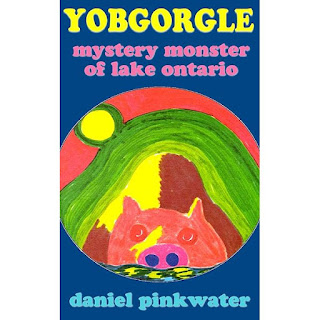If you didn't grow up reading Pinkwater, well, are you really sure you're done growing up? There's still time.
I just re-read Pinkwater's 1979 novel Yobgorgle: Mystery Monster of Lake Ontario, for the first time in probably twenty years. It's currently available in the omnibus 4 Fantastic Novels, alongside three other, well, fantastic books by Pinkwater.
This is the one in which young Eugene Winkleman is living with his Uncle Mel for the summer while his parents take an all-expenses-paid vacation to Europe that they won:
The second prize was a home videotape machine. I would have liked it better if they had won that, because I could have started a collection of science-fiction movies. But they won the trip, and off they went[.]
But then Uncle Mel has to go to Rochester, New York for work - he works on horrible-sounding vending machines that dispense things that are almost entirely unlike food - and brings Eugene with him for those two weeks.
Eugene is just a kid, so at first he doesn't have much to do in downtown Rochester while Mel is doing his training. He goes to the library and reads a bit, trying to avoid the oppressive summer heat. He's worried that he's going to be pretty bored, and not find any other kids to hang out with.
He doesn't find any other kids, but he's not bored.
Eugene sees a documentary and then reads a book, both about Professor Ambrose McFwain, head of a local scientific institute that searches for strange monsters - such as the monster of the title, supposedly resident in the local Great Lake. Eugene, somewhat bored, reaches out to the professor, and is hired as a research assistant for the next two weeks - which McFwain promises will be an exciting time in monster-hunting.
As usual, the Pinkwaterian plot gets more complicated and silly from there, bringing in the eccentric billionaire Colonel Ken Krenwinkle, who sells used cars one day a year and hunts rare and interesting cars whenever he can. Eventually, they're all out on Lake Ontario, at night, looking for the mysterious monster.
They find something, of course. It's not what they expect. It's not what you the reader expects, either. I won't say more than that. There is a big silly ending, as there must be, and it all works out pretty well for everyone involved.
As always, with Pinkwater, the point is to explore a big, weird world, full of quirky people and ideas - a world that is both weirder and stranger than ours but paradoxically more understandable and friendlier. A world where lakes will obviously have monsters in them, where billionaires do oddball things, and where multiple overlapping businesses can operate out of the basement of a factory making suits for fat men. If you ever wished you lived in a world like that, you are a born Pinkwater reader.














